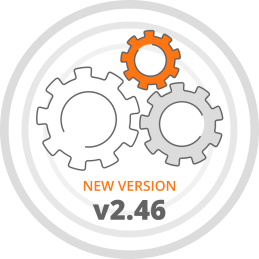
We are proud to announce the release of the latest version of Hadrone PPM – our project and portfolio management software. The new version not only brings performance and usability improvements but also introduces specific features that address the needs of our Clients who want to plan, monitor and execute their projects even more effectively. We discussed how we develop our tool and how users influence its evolution in the article „Will I have an influence on the development of Hadrone PPM?”.
So, what's new in Hadrone PPM:
1. Expansion of the "Project List" report with RAG status [ROADMAP 2025]
In the "Projects >> Project List" report, under the "Project Deadlines and Duration" section, we’ve added a "RAG report - last published" section, similar to what is shown in the "Project Status" report.
2. Editing project interdependencies also for projects in progress [ROADMAP 2025]
Previously, Project Managers/Coordinators could only create links with other projects in the preparation stage. We've extended this functionality to include projects at any status, except closed ones.
3. Permission to delete projects within a sub-portfolio [ROADMAP 2025]
We've added a new "Project Deletion" permission, available both globally and within sub-portfolios.
4. Global roles in programs [ROADMAP 2025]
We introduced global roles in programs, working the same way as global roles in projects. These can be configured and assigned to individuals within a program organization. A single user can be assigned to multiple roles.
5. Display of the number of added comments and links in the project closure report [ROADMAP 2025]
Next to the icons for comments, links, and MS Teams files (if applicable), we now show the number of items added. If no items are present, the count is not displayed. This update applies to all sections of the project closure report.
6. Change to the default date when closing a project [ROADMAP 2025]
For default project end dates, we introduced a solution similar to project start dates. The forecasted end date is suggested by default, with a button to quickly insert the current date.
7. Reminder for outdated project schedule – enhanced reminder frequency options [ROADMAP 2025]
Previously, reminders for outdated schedules could only be sent „once daily” at a set time, often leading to notification overload. We’ve added two new options (mirroring RAG report reminders):
- weekly frequency,
- monthly frequency.
8. Display of Investment Center description in “Project Budget Funding” [ROADMAP 2025]
The list of investment centers funding a project now shows their descriptions (if available). We also introduced visual improvements related to working with investment centers in projects.
9. Reports – displaying the number of rows in the report [ROADMAP 2025]
User-configurable reports now include a row count displayed above the table, on the left.
10. Presentation of the first and last period of cash flows used for financial indicator calculations [ROADMAP 2025]
In the Project >> Evaluation tab, we added a period range (months) indicator used for NPV calculations. Since the same period applies to both base and estimated NPV, it is displayed only once.
11. Commitments – files, links, comments [ROADMAP 2025]
We’ve added MS Teams files, links, and comments to financial commitments managed in the project. Additionally, we introduced new notification settings for commitments (links, comments, MS Teams files) in both global and project-specific settings. The API methods for comments and links in commitments have also been expanded to support creation and retrieval.
12. Task filtering by multiple statuses in projects [ROADMAP 2025]
Previously, filtering was limited to one task status at a time. Now, multi-select filtering is available.
13. Automatic DPP (Discounted Payback Period) calculation
We introduced automatic calculation of the discounted payback period – the number of periods needed for the discounted inflows to match the discounted outflows of a project. In other words, DPP indicates how many periods it takes for the sum of net discounted cash flows to equal zero.
Automatic DPP calculation is optional – it can be enabled in existing projects, set during project creation, or configured in project templates. The DPP value is shown both in the project and the project portfolio, including both base and estimated values.
The DPP calculation update is also reflected in project copying, reports, project cards and templates, and the API (global and local configuration, values in projects).





